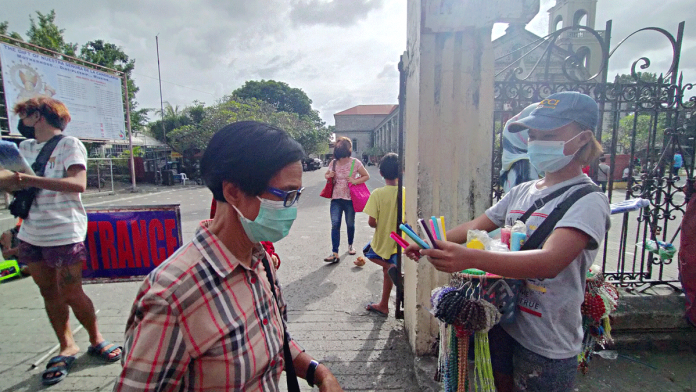
ILOILO City – Today is the popular feast of Nuestra Señora dela Candelaria (Our Lady of Candles) but the once crowded perimeter of the Jaro Metropolitan Cathedral is now devoid of devotees haggling with vendors.
With their items on display, hopeful candle and flower vendors wait for buyers even as the coronavirus pandemic takes its toll on their livelihood.
In previous years, devotees would bustle among the riot of colors with sellers wishing for an extra hand to serve the crowd.
But in this year’s patronal fiesta, business is completely different.
Speaking to Panay News, 53-year-old candle seller Josephine Bagonoc who currently resides in La Paz district said this is the first time she’s experiencing scant income in her decades of vending.
“Tama gid ka pigado tungod sang pandemic. Sang una naga-income kami masobra P3,000 [per day] pero subong pigado gid. Wala na gani makalab-ot sa P1,000,” said Bagonoc,adding that she could not even get enough profit due to the high prices of candles.
Churchgoers were also few to none during weekdays and Sundays – days their business’ only hope to recuperate, she said.
Bagonoc is selling her candles at P7 apiece and P70 each pack.
Candle vendor, Marilou Gulmatico of Barangay Benedicto, Jaro district, shared the same sentiment.
“Kis-a makalab-ot man sa P1,000 pero wala kami ginansya. Nami to ya sang nagligad nga tuig nga wala pandemic kay amo ni nga adlaw damo na nagabakal,” Gulmatico told Panay News.
With her income dipping, basic necessities at home were affected, too, she lamented.
Meanwhile, a flower seller for five years said people were not buying flowers as much as they did last year, or worse, there were just no buyers.
“Pigado gid eh. Mahal ang amon bakal sa puno tapos ang amon baligya ginhawa namon ka benta kay wala man tawo,” said Mary Grace Quintar.
She added: “Sadtong time nga wala pandemic, indi ta makasiling nga magutman kami kay maayo gawa ang income. Pero subong nga may pandemic, ang amon benta wala na sa P1,000,” she added.
Helen Talido, 61, was likewise saddened. She observed that most of the devotees only visit the cathedral to pray, thus walking past their blooms.
But Talido still hopes things would get better and “everything returns to normal.”
When asked about what they pray to the Our Lady of Candles, they have the same reply: an end to this global crisis.
The annual Jaro religious and district fiesta is considered one of the biggest in the country. Pre-pandemic, thousands of devotees converged at the century-old cathedral, the headquarters of the Archdiocese of Jaro. They queued to kiss or touch what was believed to be a miraculous image of the Virgin Mary at the cathedral balcony.
The statue was crowned by Pope John Paul II in 1981.
‘SALOG’
Jaro’s original name was Salog or Saro. It was one of the more economically-advanced areas of Iloilo City even during the Spanish occupation of the Philippines and probably the richest town of the entire colony (1521-1898).
Historical artifacts indicated that the town once conducted trade with China and Siam (Thailand) due to its port along the navigable river that ran through the town.
It was also the center of religious and economic power in the Visayas during the Spanish rule of the Philippines.
Jaro officially became a city in 1886 until it was absorbed by the city of Iloilo along with the neighboring towns of Molo, Mandurriao, La Paz and Arevalo in the early 20th century when all economic activities shifted to the port of Iloilo.
Located between Dungon Creek and the Jaro River, the district of Jaro fulfilled the ideal design for establishing communities during that era: a site between two rivers, with a church and plaza in the center, and homes of affluent families in the vicinity.
The district, notable for its 19th century architecture, was also the hometown of hero Graciano Lopez Jaena who, along with national hero Dr. Jose Rizal, established the Propaganda Movement against Spain./PN



